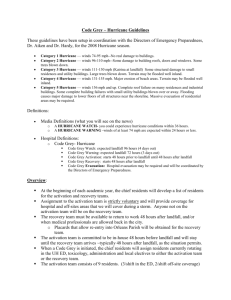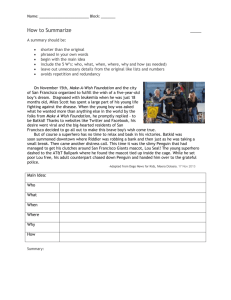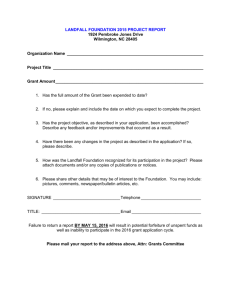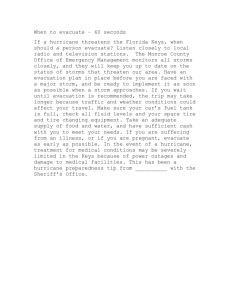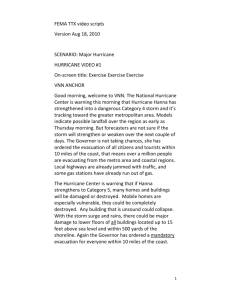Code Grey – Hurricane Guidelines
advertisement
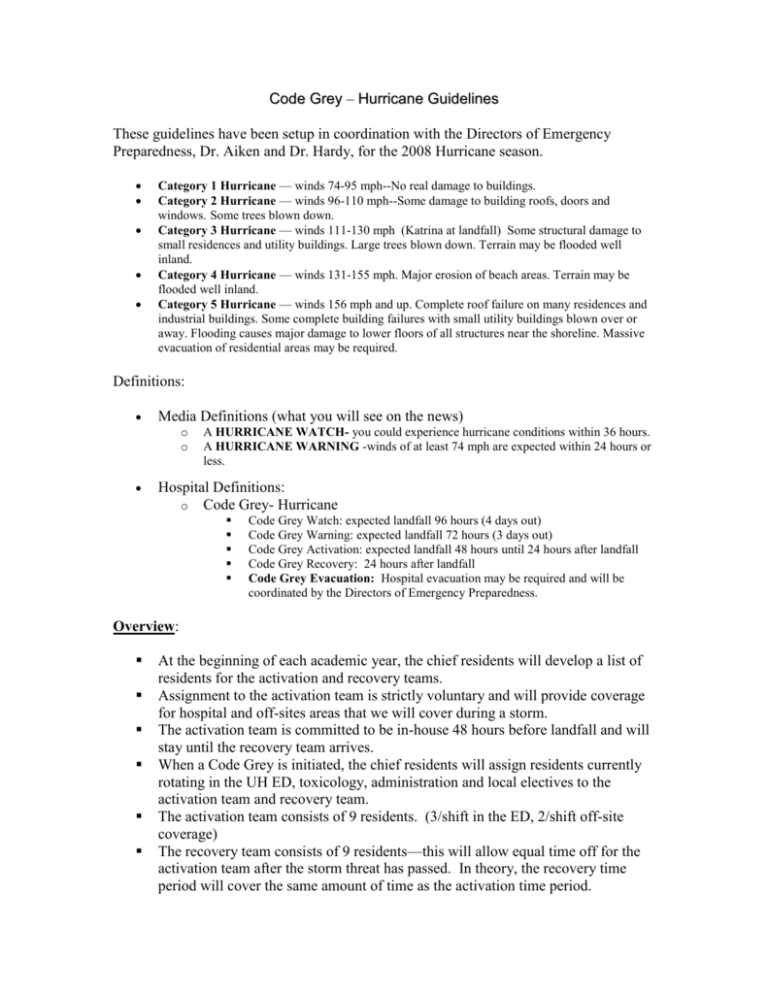
Code Grey – Hurricane Guidelines These guidelines have been setup in coordination with the Directors of Emergency Preparedness, Dr. Aiken and Dr. Hardy, for the 2008 Hurricane season. Category 1 Hurricane — winds 74-95 mph--No real damage to buildings. Category 2 Hurricane — winds 96-110 mph--Some damage to building roofs, doors and windows. Some trees blown down. Category 3 Hurricane — winds 111-130 mph (Katrina at landfall) Some structural damage to small residences and utility buildings. Large trees blown down. Terrain may be flooded well inland. Category 4 Hurricane — winds 131-155 mph. Major erosion of beach areas. Terrain may be flooded well inland. Category 5 Hurricane — winds 156 mph and up. Complete roof failure on many residences and industrial buildings. Some complete building failures with small utility buildings blown over or away. Flooding causes major damage to lower floors of all structures near the shoreline. Massive evacuation of residential areas may be required. Definitions: Media Definitions (what you will see on the news) o o A HURRICANE WATCH- you could experience hurricane conditions within 36 hours. A HURRICANE WARNING -winds of at least 74 mph are expected within 24 hours or less. Hospital Definitions: o Code Grey- Hurricane Code Grey Watch: expected landfall 96 hours (4 days out) Code Grey Warning: expected landfall 72 hours (3 days out) Code Grey Activation: expected landfall 48 hours until 24 hours after landfall Code Grey Recovery: 24 hours after landfall Code Grey Evacuation: Hospital evacuation may be required and will be coordinated by the Directors of Emergency Preparedness. Overview: At the beginning of each academic year, the chief residents will develop a list of residents for the activation and recovery teams. Assignment to the activation team is strictly voluntary and will provide coverage for hospital and off-sites areas that we will cover during a storm. The activation team is committed to be in-house 48 hours before landfall and will stay until the recovery team arrives. When a Code Grey is initiated, the chief residents will assign residents currently rotating in the UH ED, toxicology, administration and local electives to the activation team and recovery team. The activation team consists of 9 residents. (3/shift in the ED, 2/shift off-site coverage) The recovery team consists of 9 residents—this will allow equal time off for the activation team after the storm threat has passed. In theory, the recovery time period will cover the same amount of time as the activation time period. Residents will be assigned to 12-hour shifts either in the ED or at an off-site staging area. Potential Off-Site Staging Areas: Lakefront airport, Convention Center, etc, to be assigned by the Directors of Emergency Preparedness. Residents not assigned to either team are expected to be available during the recovery period for unexpected assignments. The recovery team is expected to be prepared to report for duty 24 hours after landfall. EM residents in the MICU and TICU will follow the MICU and TICU protocol for activation and recovery. Residents on community ED rotations will be released from duty at the onset of Code Grey Activation for Category 3 or above. All interns will must follow the guidelines on the service where assigned that month—in general, expect to be released from duties, if not needed to help in evacuation of patients on your service in the setting of a Category 3 or above storm. The EM offices on the 5th floor UH will act as the Residency Central Command Center and will be staffed by the program director and a chief resident during the Code Grey Warning phase. Section of Emergency Medicine Telephone Activation Tree The purpose is to facilitate the flow of information from the Program Director to all members of the residency. The tree will be activated at the onset of Code Grey Watch, and at least every 12 hours thereafter, until termination of the Code Grey, or termination of recovery. It is the responsibility of every faculty member to provide the Program Director with 2 reliable telephone numbers, and 1 alternative email address. Please sign up for the LSU emergency notification alert system: http://www.lsuhsc.edu/alerts/ In addition, Dr. Haydel will serve as EM section communication officer during code grey activations. It is anticipated that she will evacuate at the onset of code grey activation, and establish a location from which she can act as a central point of contact and will disperse updates via email and cell phone text messaging. In the event of a major storm with hospital service disruption, the program directors, program coordinators and chief residents will meet at a pre-assigned location to continue with the oversight of the residency. In the event that communications are compromised the yahoo website will be updated regularly, and temporary access will be given to family members and friends that identify themselves as looking for information about a specific resident on the activation team: http://health.groups.yahoo.com/group/LSUEM/ Phone Tree: Haydel Chief Pager & Avegno Elder PGY4s Stevens PGY3s Zorub PGY2s Cole IM/EM Chief McKay PGY1s IM/EM residents on EM side Timeline Under the direction of the Section Chief, the program director will activate the notification tree, based upon the anticipated time required for residents to secure their homes and initiate their personal hurricane plans. This will be no later than initiation of the hospital wide plan. 96 hours to landfall (Code Grey Watch) o Program Director and Chief Residents meet and establish the command center for residency in 5th floor EM offices. o A list of the Activation team must be sent to the medical director's office as soon as a Code Grey Watch is announced. o Activation Team notified in order to pack and prepare for activation. 72 hours to landfall (Code Grey Warning) o Activation Team physically checks into hospital to obtain arm bands, call rooms, parking passes and discuss plan of action with Chiefs and Program Director in EM office/5th floor. After checking in, the activation team may leave the hospital to continue home preparation and packing. o 12-hour shifts implemented in order to facilitate preparations. 48 hours to landfall (Code Grey Activation) o Activation Team must remain in-house until recovery team arrives. o Community ED residents released from duty if Cat 3 or above. o Non-essential interns released from duty at UH. Advanced Personal Preparation: Each resident is urged to formulate a personal hurricane preparation plan. This should include: A list of critical actions that must be accomplished during the short time available before the storm, such as securing pets, evacuation of family, securing the home. A list of items to pack, including 10-14 days of clothing, non-perishable food, water, bedding. A list of items that should be purchased in advance, such as rechargeable lights and batteries, a power inverter for your car (to recharge cell phones, lights, radios when the electricity fails), toiletries. A list of items needed to return to work during recovery, assuming that the city will be without power and water at the time return to work is required. Secure professional paperwork, licenses, personal photos, etc in ziplock bags. What to expect if you stay at UH during a Cat 3 or above storm: Power will go out and generators will go on. Generator power means no a/c, no elevators, no pumps in the basement, no pumping of water up to upper floors. No sewer system and no drinkable tap water. Upper floor windows will be blown out by strong winds. Communication within the hospital will be compromised, and communication with people outside the hospital will be almost nonexistent: The pager system and intranet can be expected to fail. Cell towers will be lost—although text messaging may remain intact for some. Patients and equipment will have to be moved from the first floor to the second floor if flooding occurs. Residents in the hospital will provide care to inpatients and walk-ins until the hospital is evacuated or the recovery team arrives. Residents assigned to off- site areas will provide care to patients who are at the staging areas awaiting evacuation. If the hospital is closed due to damages, the Recovery teams will be assigned (with faculty) to other sites to provide emergency care until the hospital can be reestablished.
